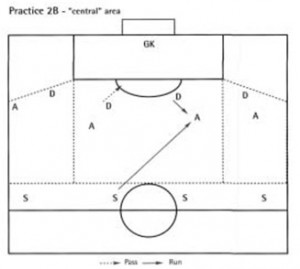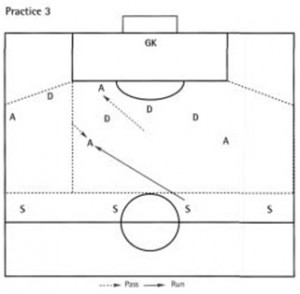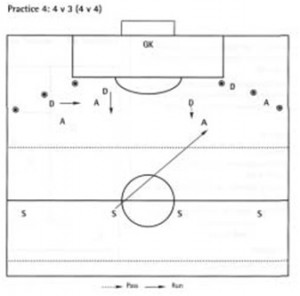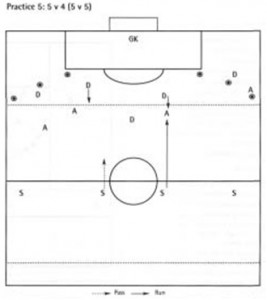The following are practices designed by Mike Pejic, former regional director for the North East FA, UK. These are great drills to work on a variety of methods when coping with your first bank of defenders. The coach can certainly be creative and incorporate their own objectives of the session to meet the outcomes. Certainly, I would recommend coaches to attempt these drills for 14 year olds and upwards.
Practice 1: 1 v 1 situations
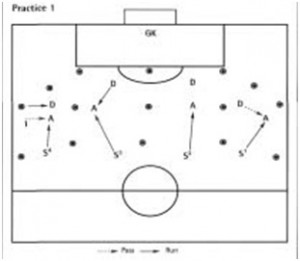 (wide and central areas in the defending third of the pitch)
(wide and central areas in the defending third of the pitch)
Organisation: 4 defenders v 4 attackers + 4 servers and 1 Goalkeeper
Area: Edge of 18 yard area (coned off)
Channels marked by cones on angle to by line .In each channel, there is 1 Defender, 1 attacker, 1 Server – rotate servers, attackers and defenders.
• Server 1 passes into A
A attempts to beat D and go on to score past the goalkeeper
• must stay in zone area coned off – once beyond the defender can cut into the penalty area
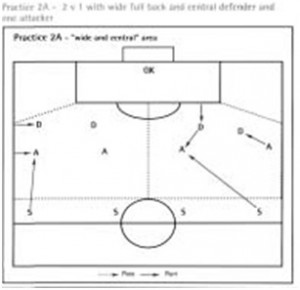 • D (defender) must stop A from beating him – holding up the attacker until a challenge can be made
• D (defender) must stop A from beating him – holding up the attacker until a challenge can be made
• Central areas, same scenario:
– Defender stopping attacker from making a shooting opportunity
– also working within zone area
Key points:
• switch on attitude – positive and intercept
• travel as ball travels
• speed/angle of approach
• decision – force play in one direction
• technique of pressure & patience – timing of challenge
• variety of service – attacker to stand in various positions to receive pass
Progression:
Server to join in after pass – 1 v 2 situation.
Practice 2B – 2 v 1 in central areas with two central defenders and attacker
• Server to pass into attacker A
• Attacker – start position in a variety of places within central or wide/central areas coned off
• both defenders react/adjust positions accordingly to attacker receiving in wide area or attacker receiving in a central area.
Key points:
• Intercept
• Technique/pressure: stop turning in central areas
• Covering defender angle, distance/cover position
• Decision – direction, adjust accordingly
– communication
– inside/outside
Progression:
• Introduce second attacker – 2 v 2
• variety of services into attackers – varied starting positions
• Server to join in supporting attackers – 2 v 3 situation
Practice 3: 3 v 2 (wide and central areas)
• 1 wide full back
• 2 attackers
• server passes into either attacker
• variety of serves
• varied start positions – receiving across defenders; receiving behind defenders
• defenders to play offside
• working one full back with two central defenders – alternate (opposite full back observing)
• link in goalkeepers
Key points:
• Pressure technique (first defender)
• cover angle/distance (second defender)
• balanced position (third defender) adjusting positions according to amount of pressure on the ball; little or no pressure on the ball – sit off, invite to feet, mark space behind
• pressure on the ball – covering players push on to attackers tighter working “shoulders” of attackers to check attackers let attacker run into offside position
Practice 4: 4 v 3
• 2 full backs
• 4 servers
• Goalkeeper
• 3 progress to 4 attackers; 4 servers
• server pass into any attacker
• vary service
• wide central areas
• to feet – space
• in front – behind
• defenders to play offside Within this practice
• defenders – handling 1 v 1 situations within a unit
• cover not necessarily important
• NOT particular on team shape, ie one to pressure the ball after three in unit working flat back line
• two full backs in advance of two central defenders – decisions on marking tight or space
• two central defenders – work as a pair (one to mark tight; one to sit tight or drop off)
• decisions – track runner or let him run (offsides); pass on; let him drop off; mark tight
• Goalkeeper to work space behind defenders.
Practice 5: 5 v 4 (5 v 5)
Attitude
• Decision – awareness of space, players)
• Adjust position accordingly to ball, player, goal
• Decision – mark tight or space
• Responsibility- handling 1 v 1 situation
• Marking – away from the ball
• Compactness – deny space, clearance
• Goalkeeper to act as a sweeper – working space, positional sense, compactness, decision, communication, technique
Progression:
• 4 v 4 – introduce fourth attacker
• 5 v 4 – one holding Midfield player in front of two Centre Backs
• 5 v 5 (one server to join in) 1 support behind – two touch
2 support in advance – free
Play varied systems against defensive unit, ie 2 wide players, 1 front player, 1 front player dropping off short.
For sure, in the above practices, the message is to defend your 1v1 situations within the boundaries of working in a unit. Therefore, it is quite common to adapt to different shapes rather than a flat line at the back.
I have used these practices and used my own coaching style to get the best out of the group I am coaching. When coaching the above to a younger age group, I will let them use autonomy and find their own ways of getting it right. For sure, I step in and give valuable input if it is required. You would expect an older group to get their techniques right, but there is always something to coach. I am pretty sure that these practices would help with most teams in Pakistan to start from the back and work out a strategy of regaining possession.


